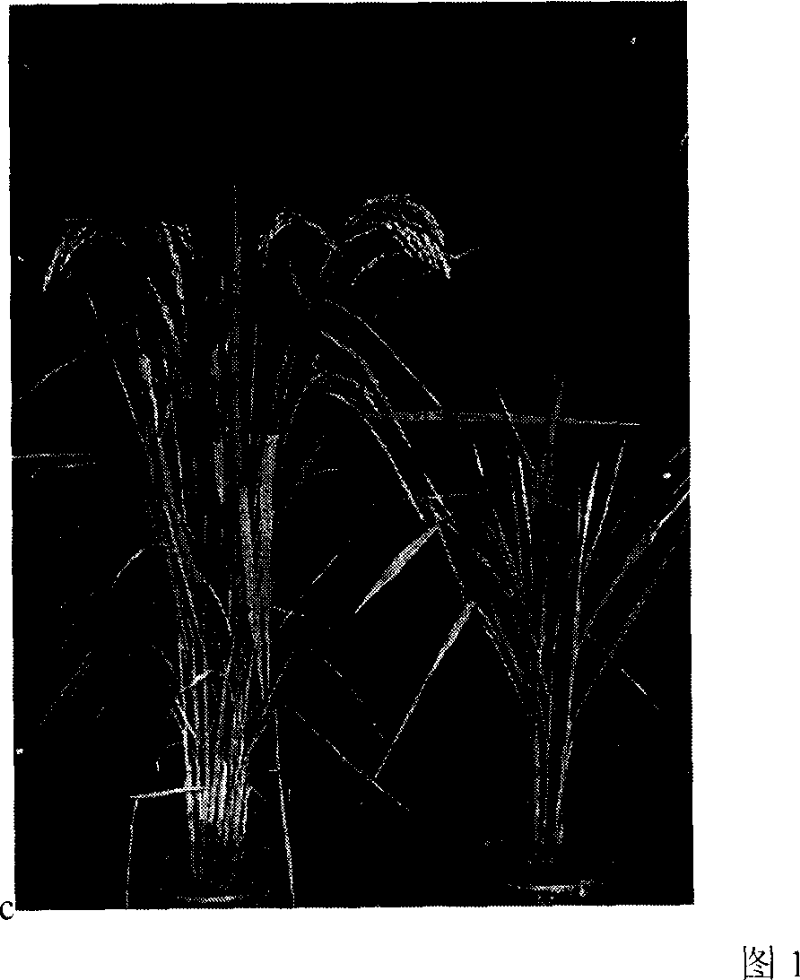Paddy cool injury gene and application
A technology for rice and cold damage, applied in the field of plant biology, can solve the problems of reduced cold sensitivity, increased cold sensitivity, and increased metastasis of yeast mutant drs2
- Summary
- Abstract
- Description
- Claims
- Application Information
AI Technical Summary
Problems solved by technology
Method used
Image
Examples
Embodiment 1
[0025] 1. Rice material
[0026] Rice (Oryza sativa) mutant osgpat1, the original wild-type material is "Zhonghua 11" japonica rice variety. The acquisition of this mutant is to use Agrobacterium-mediated genetic transformation to obtain a large number of Zhonghua No. 11 strains with T-DNA insertion tags, and the vector used for transformation is pFX-E24.2-R15 (Wu et al., Development of enhancer trap lines for functional analysis of the rice genome. Plant J. 2003, 35(3): 418-27.), the transformant was obtained by screening. Transformed plants are now T 0 Generation, T 0 T 1 Substitute plant, this plant is planted in paddy field by the interval of 5 cun * 8 cun, carries out field management by conventional paddy planting method. Through screening, a rice mutant Osgpat1 with stable phenotype was obtained, which was slightly shorter, had fewer tillers, and was very sensitive to low temperature.
[0027] 2. Isolation of T-DNA insertion flanking sequences.
[0028] The T-DNA ...
Embodiment 2
[0155] Embodiment 2: Mutant and control seedling low temperature stress test
[0156] Seeds of the Osgpat1 mutant and wild type were soaked at 25°C for 3 days, germinated at 37°C for 2 days, and then planted in paddy soil for about 20 days. There were 17 strains in the mutant mutants that had obvious changes, with curled leaves and severe withering, while 20 wild-type plants had no change (Fig. 4). This shows that the mutation of OsGPAT1 gene has a very important impact on plant frost resistance.
Embodiment 3
[0157] Example 3: Overexpression of the Osgpat1 gene
[0158] The vector used for overexpression is pU1301 constructed in our laboratory. pU1301 is the basis of pCAMBIA1301 (Sun et al., 2004, Xa26, a gene conferring resistance to Xanthomonas oryzae pv. oryzae in rice, encoding a LRR receptorkinase-like protein. Plant Journal. 37: 517-527), a commonly used plant genetic transformation vector in the world (Figure 6), an Agrobacterium-mediated genetic transformation vector carrying a maize ubiquitin promoter with constitutive and overexpression characteristics. The pCAMBIA1301 vector was kindly provided by the Australian CAMBIA Laboratory (Center for the Application of Molecular Biology to International Agriculture).
[0159] PCR primers gpatoef and gpatoer were designed to amplify the complete ORF of OsGPAT1 gene from the rice genome, and Kpn I and BamH I restriction sites were added to the PCR primers respectively.
[0160] The sequences of gpatoef and gpatoer are:
[0161] ...
PUM
 Login to View More
Login to View More Abstract
Description
Claims
Application Information
 Login to View More
Login to View More - R&D
- Intellectual Property
- Life Sciences
- Materials
- Tech Scout
- Unparalleled Data Quality
- Higher Quality Content
- 60% Fewer Hallucinations
Browse by: Latest US Patents, China's latest patents, Technical Efficacy Thesaurus, Application Domain, Technology Topic, Popular Technical Reports.
© 2025 PatSnap. All rights reserved.Legal|Privacy policy|Modern Slavery Act Transparency Statement|Sitemap|About US| Contact US: help@patsnap.com



